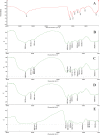Silk nanoparticles for the protection and delivery of guava leaf (Psidium guajava L.) extract for cosmetic industry, a new approach for an old herb
- PMID: 36694964
- PMCID: PMC9879179
- DOI: 10.1080/10717544.2023.2168793
Silk nanoparticles for the protection and delivery of guava leaf (Psidium guajava L.) extract for cosmetic industry, a new approach for an old herb
Abstract
Guava (Psidium guajava L.) is a well-known plant containing high levels of natural antioxidants, the phenolic compounds, which have been employed in numerous cosmetic products. However, these molecules are unstable to oxidants, light, temperature, pH, water, and enzymatic activities. Therefore, to enhance their stability and preserve their antioxidant activity, this study investigated the silk fibroin nanoparticles (SFNs) ability to encapsulate, deliver, and heat-protect the phenolic compounds of the guava leaves ethanolic extract. Firstly, the guava ethanolic extract was produced by maceration, which possessed a total phenolic content of 312.6 mg GAE/g DPW and a high antioxidant activity (IC50 = 5.397 ± 0.618 µg/mL). Then, the extract loaded SFNs were manufactured by desolvation method, and the particles demonstrated appropriate sizes of 200-700 nm with narrow size distribution, spherical shape, silk-II crystalline structure, high drug entrapment efficiency of > 70% (dependent on the fibroin content), and a two-phase sustained drug release for at least 210 min. Using the 2,2-diphenyl-1-picrylhydrazyl (DPPH) assay, the antioxidant activity of the guava extract was well-preserved in the extract loaded SFNs. Finally, after being treated with high temperature of 70 °C for 24 h, the guava extract almost loses all of its antioxidant property (5 times decrement), whereas the extract loaded SFNs could retain the extract activity. Conclusively, the SFNs proved much potential to deliver and heat-protect the guava extract phenolic compounds, and preserve their antioxidant activity. Confirmed by this case, SFNs could be further explored in protecting other natural compounds from environmental factors.
Keywords: Psidium guajava L.; Silk fibroin; antioxidant; guava; heat-protection; nanoparticles.
Conflict of interest statement
None to declare.
Figures





Similar articles
-
Bioactive Compounds from Guava Leaves (Psidium guajava L.): Characterization, Biological Activity, Synergistic Effects, and Technological Applications.Molecules. 2025 Mar 12;30(6):1278. doi: 10.3390/molecules30061278. Molecules. 2025. PMID: 40142053 Free PMC article. Review.
-
Antioxidant power of phytochemicals from Psidium guajava leaf.J Zhejiang Univ Sci. 2004 Jun;5(6):676-83. doi: 10.1007/BF02840979. J Zhejiang Univ Sci. 2004. PMID: 15101101
-
Crystal Guava (Psidium guajava L. "Crystal"): Evaluation of In Vitro Antioxidant Capacities and Phytochemical Content.ScientificWorldJournal. 2020 Sep 1;2020:9413727. doi: 10.1155/2020/9413727. eCollection 2020. ScientificWorldJournal. 2020. PMID: 32952456 Free PMC article.
-
Exploratory Characterization of Phenolic Compounds with Demonstrated Anti-Diabetic Activity in Guava Leaves at Different Oxidation States.Int J Mol Sci. 2016 May 11;17(5):699. doi: 10.3390/ijms17050699. Int J Mol Sci. 2016. PMID: 27187352 Free PMC article.
-
Health Effects of Psidium guajava L. Leaves: An Overview of the Last Decade.Int J Mol Sci. 2017 Apr 24;18(4):897. doi: 10.3390/ijms18040897. Int J Mol Sci. 2017. PMID: 28441777 Free PMC article. Review.
Cited by
-
Microemulsion-based topical hydrogels containing lemongrass leaf essential oil (Cymbopogon citratus (DC.) Stapf) and mango seed kernel extract (Mangifera indica Linn) for acne treatment: Preparation and in-vitro evaluations.PLoS One. 2024 Oct 31;19(10):e0312841. doi: 10.1371/journal.pone.0312841. eCollection 2024. PLoS One. 2024. PMID: 39480758 Free PMC article.
-
PEGylated Silk Fibroin Nanoparticles for Oral Antibiotic Delivery: Insights into Drug-Carrier Interactions and Process Greenness.ACS Omega. 2025 Mar 14;10(11):11627-11641. doi: 10.1021/acsomega.5c01089. eCollection 2025 Mar 25. ACS Omega. 2025. PMID: 40160786 Free PMC article.
-
Bioactive Compounds from Guava Leaves (Psidium guajava L.): Characterization, Biological Activity, Synergistic Effects, and Technological Applications.Molecules. 2025 Mar 12;30(6):1278. doi: 10.3390/molecules30061278. Molecules. 2025. PMID: 40142053 Free PMC article. Review.
-
Silk-based microparticles for the adsorption of methylene blue: formulations, characterization, adsorption study, in silico molecular docking, and molecular dynamics simulation.RSC Adv. 2025 Apr 30;15(18):14042-14057. doi: 10.1039/d5ra02266e. eCollection 2025 Apr 28. RSC Adv. 2025. PMID: 40309125 Free PMC article.
-
Onto the differences in formulating micro-/nanoparticulate drug delivery system from Thai silk and Vietnamese silk: A critical comparison.Heliyon. 2023 Jun 2;9(6):e16966. doi: 10.1016/j.heliyon.2023.e16966. eCollection 2023 Jun. Heliyon. 2023. PMID: 37484260 Free PMC article.
References
-
- Altiok E, Bayçin D, Bayraktar O, Ülkü S. (2008). Isolation of polyphenols from the extracts of olive leaves (Olea europaea L.) by adsorption on silk fibroin. Sep Purif Technol 62:1–9.
-
- Altman GH, Diaz F, Jakuba C, et al. (2003). Silk-based biomaterials. Biomaterials 24:401–16. - PubMed
-
- Alvarez-Suarez JM, Giampieri F, Gasparrini M, et al. (2018). Guava (Psidium guajava L. cv. Red Suprema) crude extract protect human dermal fibroblasts against cytotoxic damage mediated by oxidative stress. Plant Foods Hum Nutr 73:18–24. - PubMed
-
- Bayçin D, Altiok E, Ülkü S, Bayraktar O. (2007). Adsorption of olive leaf (Olea europaea L.) antioxidants on silk fibroin. J Agric Food Chem 55:1227–36. - PubMed
-
- Chen HY, Yen GC. (2007). Antioxidant activity and free radical-scavenging capacity of extracts from guava (Psidium guajava L.) leaves. Food Chem 101:686–94.
MeSH terms
Substances
LinkOut - more resources
Full Text Sources
